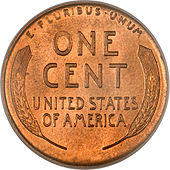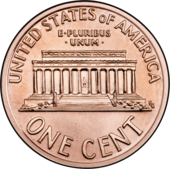Wheat cent
| United States | |
| Value | 1 cent (.01 US dollars) |
|---|---|
| Mass | 2.5 g (current composition). Bronze cents from 1909 to 1982 are 3.11 g; wartime steel cents, depending on when in 1943 they were struck, are 2.69 g or 2.75 g |
| Diameter | 19.05 mm (0.750 in) |
| Edge | Plain |
| Composition | 1909–1942, 1944–1982: 95% copper, remainder tin or zinc 1943: zinc-plated steel 1982–present: copper-plated zinc (97.5% Zn, 2.5% Cu) |
| Years of minting | 1909–present |
| Mint marks | P (2017 only), D, S. Under date on obverse. No mint marks used from 1965 to 1967, or in any year except 2017 at the Philadelphia Mint. |
| Obverse | |
 |
|
| Design | Abraham Lincoln |
| Designer | Victor D. Brenner |
| Design date | 1909 (before 1918 omitting VDB on the cutoff of the bust; modified in 2010) |
| Reverse | |
 |
|
| Design | Union shield |
| Designer | Lyndall Bass |
| Design date | 2010 |
| Reverses of the Lincoln cent |
|---|
The Lincoln cent (or sometimes called Lincoln penny) is a one-cent coin that has been struck by the United States Mint since 1909. The obverse or heads side was designed by Victor David Brenner, as was the original reverse. The coin has seen several reverse, or tails, designs and now bears one by Lyndall Bass depicting a Union shield. All coins struck by the United States government with a value of 1/100 of a dollar are called cents because the United States has always minted coins using decimals. The penny nickname is a carryover from the coins struck in England, which went to decimals for coins in 1971.
In 1905, sculptor Augustus Saint-Gaudens was hired by the Mint to redesign the cent and the four gold coins, which did not require congressional approval. Two of Saint-Gaudens's proposed designs for the cent were eventually adapted for the gold pieces, but Saint-Gaudens died in August 1907 before submitting additional designs for the cent. In January 1909, the Mint engaged Brenner to design a cent depicting the late president Abraham Lincoln, 1909 being the centennial year of his birth. It was the first widely circulating design of a U.S. president on a coin, an idea that had been seen as too monarchical in the past, namely by George Washington. Nevertheless, Brenner's design was eventually approved, and the new coins were issued to great public interest on August 2, 1909.
Brenner's initials (VDB), on the reverse at its base, were deemed too prominent once the coins were issued, and were removed within days of the release. The initials were restored, this time smaller, on Lincoln's shoulder, in 1918. Brenner's reverse was replaced in 1959 by a depiction of the Lincoln Memorial designed by Frank Gasparro, for the sesquicentennial of his birth year. The Lincoln Memorial reverse was itself replaced in 2009 by commemorative designs marking the bicentennial of Lincoln's birth. Beginning in 2010, Bass's shield design was coined. Originally struck in 95% copper, the cent coin was changed for one year to steel in 1943 as copper was needed to aid in the war effort. The mint then reverted to 95% copper until 1982, when inflation made copper too expensive and the composition was changed to zinc with an outer copper layer.
...
Wikipedia







